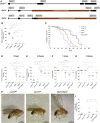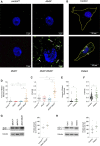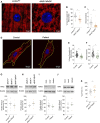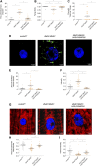A new model for fatty acid hydroxylase-associated neurodegeneration reveals mitochondrial and autophagy abnormalities
- PMID: 36589738
- PMCID: PMC9794614
- DOI: 10.3389/fcell.2022.1000553
A new model for fatty acid hydroxylase-associated neurodegeneration reveals mitochondrial and autophagy abnormalities
Abstract
Fatty acid hydroxylase-associated neurodegeneration (FAHN) is a rare disease that exhibits brain modifications and motor dysfunctions in early childhood. The condition is caused by a homozygous or compound heterozygous mutation in fatty acid 2 hydroxylase (FA2H), whose encoded protein synthesizes 2-hydroxysphingolipids and 2-hydroxyglycosphingolipids and is therefore involved in sphingolipid metabolism. A few FAHN model organisms have already been established and give the first insight into symptomatic effects. However, they fail to establish the underlying cellular mechanism of FAHN so far. Drosophila is an excellent model for many neurodegenerative disorders; hence, here, we have characterized and validated the first FAHN Drosophila model. The investigation of loss of dfa2h lines revealed behavioral abnormalities, including motor impairment and flying disability, in addition to a shortened lifespan. Furthermore, alterations in mitochondrial dynamics, and autophagy were identified. Analyses of patient-derived fibroblasts, and rescue experiments with human FA2H, indicated that these defects are evolutionarily conserved. We thus present a FAHN Drosophila model organism that provides new insights into the cellular mechanism of FAHN.
Keywords: Drosophila melanogaster; FA2H; autophagy; fatty acid hydroxylase-associated neurodegeneration; mitochondria.
Copyright © 2022 Mandik, Kanana, Rody, Misera, Wilken, Laabs von Holt, Klein and Vos.
Conflict of interest statement
The authors declare that the research was conducted in the absence of any commercial or financial relationships that could be construed as a potential conflict of interest.
Figures




Similar articles
-
Fatty Acid 2-Hydroxylase and 2-Hydroxylated Sphingolipids: Metabolism and Function in Health and Diseases.Int J Mol Sci. 2023 Mar 3;24(5):4908. doi: 10.3390/ijms24054908. Int J Mol Sci. 2023. PMID: 36902339 Free PMC article. Review.
-
Novel Homozygous FA2H Variant Causing the Full Spectrum of Fatty Acid Hydroxylase-Associated Neurodegeneration (SPG35).Genes (Basel). 2023 Dec 20;15(1):14. doi: 10.3390/genes15010014. Genes (Basel). 2023. PMID: 38275596 Free PMC article.
-
Novel biallelic FA2H mutations in a Japanese boy with fatty acid hydroxylase-associated neurodegeneration.Brain Dev. 2020 Feb;42(2):217-221. doi: 10.1016/j.braindev.2019.11.006. Epub 2019 Dec 16. Brain Dev. 2020. PMID: 31837835
-
Generation of the human iPSC line AKOSi010-A from fibroblasts of a female FAHN patient, carrying the compound heterozygous mutation p.Gly45Arg/p.His319Arg.Stem Cell Res. 2022 Aug;63:102863. doi: 10.1016/j.scr.2022.102863. Epub 2022 Jul 12. Stem Cell Res. 2022. PMID: 35843022
-
Unraveling Novel Mechanisms of Neurodegeneration Through a Large-Scale Forward Genetic Screen in Drosophila.Front Genet. 2019 Jan 14;9:700. doi: 10.3389/fgene.2018.00700. eCollection 2018. Front Genet. 2019. PMID: 30693015 Free PMC article. Review.
Cited by
-
Fatty Acid 2-Hydroxylase and 2-Hydroxylated Sphingolipids: Metabolism and Function in Health and Diseases.Int J Mol Sci. 2023 Mar 3;24(5):4908. doi: 10.3390/ijms24054908. Int J Mol Sci. 2023. PMID: 36902339 Free PMC article. Review.
-
Loss of Fic causes progressive neurodegeneration in a Drosophila model of hereditary spastic paraplegia.Biochim Biophys Acta Mol Basis Dis. 2024 Oct;1870(7):167348. doi: 10.1016/j.bbadis.2024.167348. Epub 2024 Jul 8. Biochim Biophys Acta Mol Basis Dis. 2024. PMID: 38986817
-
Iron Dyshomeostasis in Neurodegeneration with Brain Iron Accumulation (NBIA): Is It the Cause or the Effect?Cells. 2024 Aug 19;13(16):1376. doi: 10.3390/cells13161376. Cells. 2024. PMID: 39195264 Free PMC article. Review.
References
LinkOut - more resources
Full Text Sources
Molecular Biology Databases

